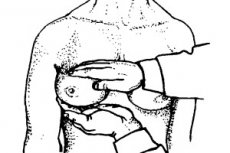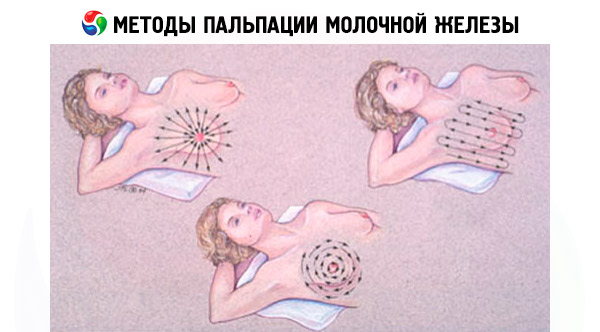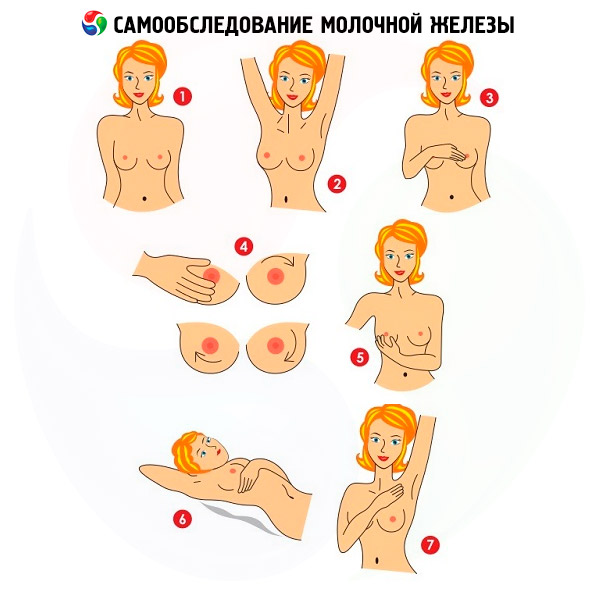
All iLive content is medically reviewed or fact checked to ensure as much factual accuracy as possible.
We have strict sourcing guidelines and only link to reputable media sites, academic research institutions and, whenever possible, medically peer reviewed studies. Note that the numbers in parentheses ([1], [2], etc.) are clickable links to these studies.
If you feel that any of our content is inaccurate, out-of-date, or otherwise questionable, please select it and press Ctrl + Enter.
Palpation of the breast
Medical expert of the article
Last reviewed: 06.07.2025

Palpation of the mammary gland is the simplest, but quite informative method of examining the breast, which can be carried out by a doctor or the woman herself. The purpose of palpation is to promptly detect possible diseases in the gland. After all, the earlier the pathology is detected, the more optimistic the prognosis for recovery. This is especially true for tumors, including breast cancer.
Examination and palpation of the mammary glands is carried out very carefully and attentively. Palpation begins with the upper internal quadrant, gradually moving to the outer upper quadrant, then capturing the lower quadrants and the areola.
If there is discharge from the milk ducts, then you should pay attention to their color, consistency, and quantity. Discharge is a very valuable biological and diagnostic material that cannot be ignored.
Every suspicious sign needs to be assessed, and it is best to do this together with a doctor.
Who to contact?
Examination and palpation of the mammary glands
- What is the basic algorithm for palpation of the mammary glands?
The woman is examined from two positions: standing and lying on the couch. When examining the breast, special attention is paid to the presence of deformations, asymmetry, swelling, redness, spider veins, places of skin retraction (uimplication). The nipple and areola area are always examined, assessing the skin color, retraction or convexity, and other characteristics. After this, they begin to palpate the armpit area, where the lymph nodes closest to the mammary glands are located.

- What is the basic technique of breast palpation?
Self-palpation (self-examination) or medical examination of the mammary glands is recommended to be practiced from the age of 25. It is better to perform palpation once a month, preferably on the same day of the monthly cycle (preferably on the 7-10th day of menstruation).

Immediately before the procedure, you should carefully examine your underwear - is there any discharge from the nipples? Next, you need to examine your glands in front of a mirror for deformations, asymmetries, etc. If everything is in order, you can proceed to palpation:
- carefully palpate the skin and tissues of the gland, moving from quadrant to quadrant and ending with the central area of the nipple and axillary areas;
- Be sure to pay attention to the slightest seals, nodules, pits, erosions, suspicious wrinkled formations;
- the left gland should be palpated with the right hand, and vice versa;
- You should not press hard on the chest - the sliding should be light, using three or four fingers of the hand;
- palpation should cover not only the chest, but also the ribs and sternum;
- It is recommended to carry out palpation in different positions of the arms and body.
Before palpation, it is recommended to lubricate the arms and chest with a nourishing or massage cream to increase the comfort of the procedure.
- How is palpation of a breast cyst performed?
A generally recognized effective method of palpating cystic formations is the technique of changing the position of the woman's hands. It consists of certain stages:
- the woman's hands are placed on her hips (this is the best position for relaxing the chest muscles);
- the woman presses her hips with her hands, tensing her chest muscles;
- raises his outstretched arms together upwards (to determine umbilication, a sign of a malignant breast tumor);
- standing, leans forward.
Palpation of the glands is carried out using all the listed positions. Most often, they make it possible to detect features that are not determined by standard palpation.
- How to detect breast cancer by palpation?
Visually, nipple displacement, presence of retraction or swelling, change in color and appearance of the skin are detected. An important criterion is the symptom of umbilication - this is the appearance of a depression in the tissue of the organ, which is considered one of the signs of infiltrative cancer. Also, a cancerous tumor is characterized by the symptom of "lemon peel" - these are specific changes in the skin, which is located above the malignant lesion. The appearance of the skin resembles the peel of a lemon or orange, which is explained by the blockage of the lymphatic channels by the cancerous formation.
By palpation, it is possible to determine the presence of nodes, dense areas, cords, etc. Such seals are often painless, have irregular outlines, uneven borders, they seem to be fused with the nearest tissues. At the same time, discharge from the milk ducts may appear, which is also an unfavorable symptom.
A disease such as Paget's disease can be identified by the presence of scales and crusts in the areola area, as well as by thickening of the nipple.
- What are the signs that the gland is healthy?
Healthy mammary glands are rounded and symmetrical. The skin over the glands is clean, without visible changes. The consistency is soft and elastic, without compactions or nodular formations.
The mammary glands can take on different appearances depending on the monthly phase, which often alarms many women. It is normal if immediately before or during menstruation the breasts become sensitive, increase in size, and the nipple becomes slightly painful.
By the way, pain during palpation of the mammary gland in most cases indicates a benign process: malignant tumors, as a rule, are not accompanied by pain. If the gland hurts during palpation, then this may be a sign of mastitis, fibrocystic mastopathy, etc.
- Is palpation of the mammary glands performed in the postpartum period?
During the first few days of the postpartum period, the doctor must monitor the condition of the mother. At first, the consistency, size and contractility of the uterus are monitored, and special attention is paid to vaginal discharge. Already 4 hours after birth, as well as in the following few days, the doctor determines the condition of the mammary glands - whether they are ready to feed the child. Attention is paid to breast enlargement, the absence of signs of inflammation (redness, increased local temperature, painful seals).
Normally, during pregnancy, elevated levels of estradiol, progesterone and other hormones provoke accelerated development of glandular tissue. Throughout pregnancy, lactation is suppressed by steroid hormones produced in the placenta. At the end of labor, their amount drops sharply and, under the influence of prolactin,breast milk begins to be secreted. If a woman does not breastfeed, or the child does not suck out the required amount of milk, then lactostasis may develop - stagnation of milk in the mammary gland. Palpation of this condition is detected in the form of sharply painful seals and an increase in the temperature of the skin in the glands. If this happens, it is better not to waste time and consult a doctor.
If palpation of the mammary gland ends with the detection of a suspicious lump or tubercle, do not be alarmed immediately. It is better to contact a specialist, go through the necessary stages of examination - most often it turns out that there is no reason to worry. However, it is important not to forget that a timely visit to a doctor often helps prevent serious health problems.


 [
[